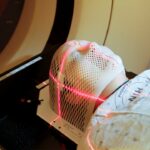Delayed anaphylaxis is a severe allergic reaction that occurs hours after exposure to an allergen. This type of allergic reaction is not as common as immediate anaphylaxis, which occurs within minutes of exposure to an allergen. Delayed anaphylaxis can be triggered by a variety of allergens, including foods, medications, and environmental factors. When the body is exposed to an allergen, it produces an immune response that can lead to the release of histamine and other chemicals, causing symptoms such as hives, swelling, difficulty breathing, and in severe cases, anaphylactic shock.
Delayed anaphylaxis can be particularly challenging to diagnose and treat because the symptoms may not appear until several hours after exposure to the allergen. This delayed onset can make it difficult for individuals to identify the trigger and seek prompt medical attention. It is important for individuals who have experienced delayed anaphylaxis to work closely with their healthcare providers to identify potential triggers and develop a plan for managing future allergic reactions.
Key Takeaways
- Delayed anaphylaxis is a rare but serious allergic reaction that can occur hours after exposure to an allergen.
- Causes of delayed anaphylaxis after laser tattoo removal can include the breakdown of tattoo ink particles and the body’s immune response to them.
- Symptoms of delayed anaphylaxis may include hives, swelling, difficulty breathing, and low blood pressure, and diagnosis may involve skin testing and blood tests.
- Treatment options for delayed anaphylaxis may include antihistamines, corticosteroids, and epinephrine, and prevention may involve avoiding known allergens and carrying an epinephrine auto-injector.
- Risks and complications of laser tattoo removal may include scarring, infection, and allergic reactions, and future considerations may involve improved tattoo ink formulations and allergy testing prior to treatment.
Causes of Delayed Anaphylaxis after Laser Tattoo Removal
Laser tattoo removal is a popular cosmetic procedure that uses high-intensity light beams to break up the pigment in a tattoo. While the procedure is generally safe, there have been reported cases of delayed anaphylaxis following laser tattoo removal. The cause of delayed anaphylaxis in these cases is not fully understood, but it is believed to be related to the breakdown of tattoo pigment and the release of allergens into the body.
One possible explanation for delayed anaphylaxis after laser tattoo removal is the release of metal ions from the tattoo pigment. Many tattoo pigments contain metal compounds such as iron oxide, titanium dioxide, and mercury sulfide, which can be broken down by the laser during the removal process. These metal ions may then trigger an immune response in some individuals, leading to delayed anaphylaxis. Additionally, the breakdown of tattoo pigment can release other unknown allergens into the body, further contributing to the development of delayed allergic reactions.
Symptoms and Diagnosis of Delayed Anaphylaxis
The symptoms of delayed anaphylaxis can vary widely from person to person, but commonly include hives, swelling, itching, and difficulty breathing. In severe cases, delayed anaphylaxis can progress to anaphylactic shock, which is a life-threatening emergency that requires immediate medical attention. It is important for individuals who have experienced delayed anaphylaxis to seek medical care as soon as symptoms appear.
Diagnosing delayed anaphylaxis can be challenging due to the delayed onset of symptoms. Healthcare providers may use a combination of medical history, physical examination, and allergy testing to identify potential triggers and confirm a diagnosis of delayed anaphylaxis. Allergy testing may include skin prick tests, blood tests, or oral food challenges to determine specific allergens that may be causing the allergic reaction.
Treatment Options for Delayed Anaphylaxis
| Treatment Options | Description |
|---|---|
| Epinephrine | The first-line treatment for anaphylaxis, it helps to reverse the symptoms and improve breathing. |
| Antihistamines | Can help relieve itching, hives, and other mild symptoms of anaphylaxis. |
| Corticosteroids | May be used to reduce inflammation and prevent a possible late-phase reaction. |
| Bronchodilators | Used to open the airways and improve breathing in cases of severe respiratory symptoms. |
The treatment for delayed anaphylaxis typically involves managing symptoms and preventing future allergic reactions. In cases of mild to moderate delayed anaphylaxis, over-the-counter antihistamines such as cetirizine or loratadine may be used to relieve symptoms such as itching and hives. In more severe cases, prescription medications such as epinephrine may be necessary to treat anaphylactic shock and prevent further complications.
In addition to medication, individuals who have experienced delayed anaphylaxis should work with their healthcare providers to identify and avoid potential triggers. This may involve making dietary changes, avoiding certain medications or environmental factors, and carrying emergency medications such as epinephrine auto-injectors in case of future allergic reactions.
Prevention of Delayed Anaphylaxis
Preventing delayed anaphylaxis involves identifying and avoiding potential triggers that may cause allergic reactions. Individuals who have experienced delayed anaphylaxis should work closely with their healthcare providers to determine specific allergens that may be causing their allergic reactions. This may involve allergy testing and keeping a detailed record of symptoms and potential triggers.
In the case of delayed anaphylaxis following laser tattoo removal, individuals should consider the potential risks before undergoing the procedure. It is important to research the safety and reputation of the tattoo removal facility, as well as discuss any concerns with a healthcare provider before proceeding with the treatment. Additionally, individuals with a history of allergic reactions should inform their tattoo removal specialist about their allergies to ensure appropriate precautions are taken during the procedure.
Risks and Complications of Laser Tattoo Removal

While laser tattoo removal is generally considered safe, there are potential risks and complications associated with the procedure. In addition to delayed anaphylaxis, other potential side effects of laser tattoo removal include skin irritation, scarring, infection, and changes in skin pigmentation. It is important for individuals considering laser tattoo removal to discuss these potential risks with a healthcare provider and carefully weigh the benefits and drawbacks of the procedure.
In some cases, individuals may experience allergic reactions to specific components of the tattoo pigment itself. This can lead to localized allergic reactions at the site of the tattoo removal, including redness, swelling, and itching. Individuals with a history of allergies or sensitive skin should discuss these concerns with their tattoo removal specialist before undergoing the procedure.
Conclusion and Future Considerations
Delayed anaphylaxis is a serious allergic reaction that can occur hours after exposure to an allergen. While the exact cause of delayed anaphylaxis following laser tattoo removal is not fully understood, it is believed to be related to the breakdown of tattoo pigment and the release of allergens into the body. Individuals who have experienced delayed anaphylaxis should work closely with their healthcare providers to identify potential triggers and develop a plan for managing future allergic reactions.
In conclusion, it is important for individuals considering laser tattoo removal to be aware of the potential risks and complications associated with the procedure. By working closely with their healthcare providers and discussing any concerns or allergies before undergoing laser tattoo removal, individuals can take steps to minimize the risk of delayed anaphylaxis and other potential side effects. As research in this area continues to evolve, it is important for healthcare providers and individuals alike to stay informed about the latest developments in laser tattoo removal safety and potential allergic reactions.
If you’ve experienced delayed anaphylaxis after laser tattoo removal, you’re not alone. It’s important to be aware of potential complications and side effects associated with laser procedures. In fact, a recent article on inlaserhairremoval.com discusses the relationship between hidradenitis suppurativa and laser hair removal, shedding light on the importance of understanding how different skin conditions can interact with laser treatments. It’s crucial to stay informed and consult with a qualified professional before undergoing any laser procedure.
FAQs
What is delayed anaphylaxis?
Delayed anaphylaxis is a severe allergic reaction that occurs several hours after exposure to an allergen. It can be life-threatening and requires immediate medical attention.
What are the symptoms of delayed anaphylaxis?
Symptoms of delayed anaphylaxis can include hives, swelling, difficulty breathing, wheezing, rapid heart rate, low blood pressure, and gastrointestinal symptoms such as nausea, vomiting, and diarrhea.
What is laser tattoo removal?
Laser tattoo removal is a procedure that uses high-powered lasers to break down the ink particles in a tattoo, allowing the body to naturally eliminate them. It is often used to remove unwanted tattoos.
Can delayed anaphylaxis occur after laser tattoo removal?
Yes, delayed anaphylaxis can occur after laser tattoo removal if the patient has an allergic reaction to the ink particles or other components of the tattoo ink.
How is delayed anaphylaxis after laser tattoo removal treated?
Treatment for delayed anaphylaxis after laser tattoo removal may include administration of epinephrine, antihistamines, and corticosteroids to manage the allergic reaction. In severe cases, hospitalization and close monitoring may be necessary.






